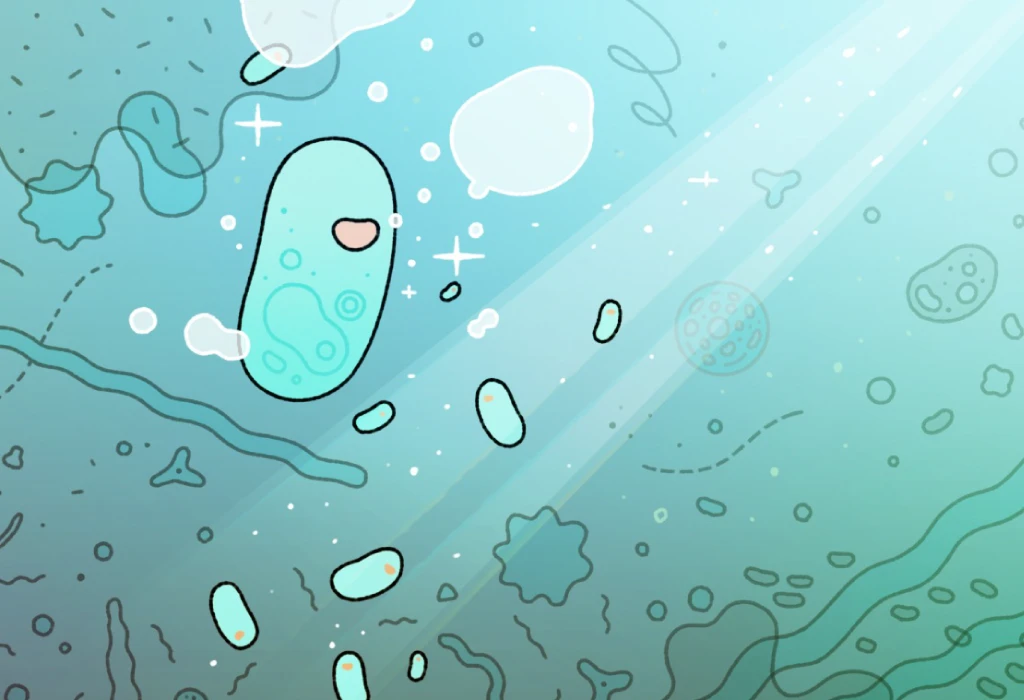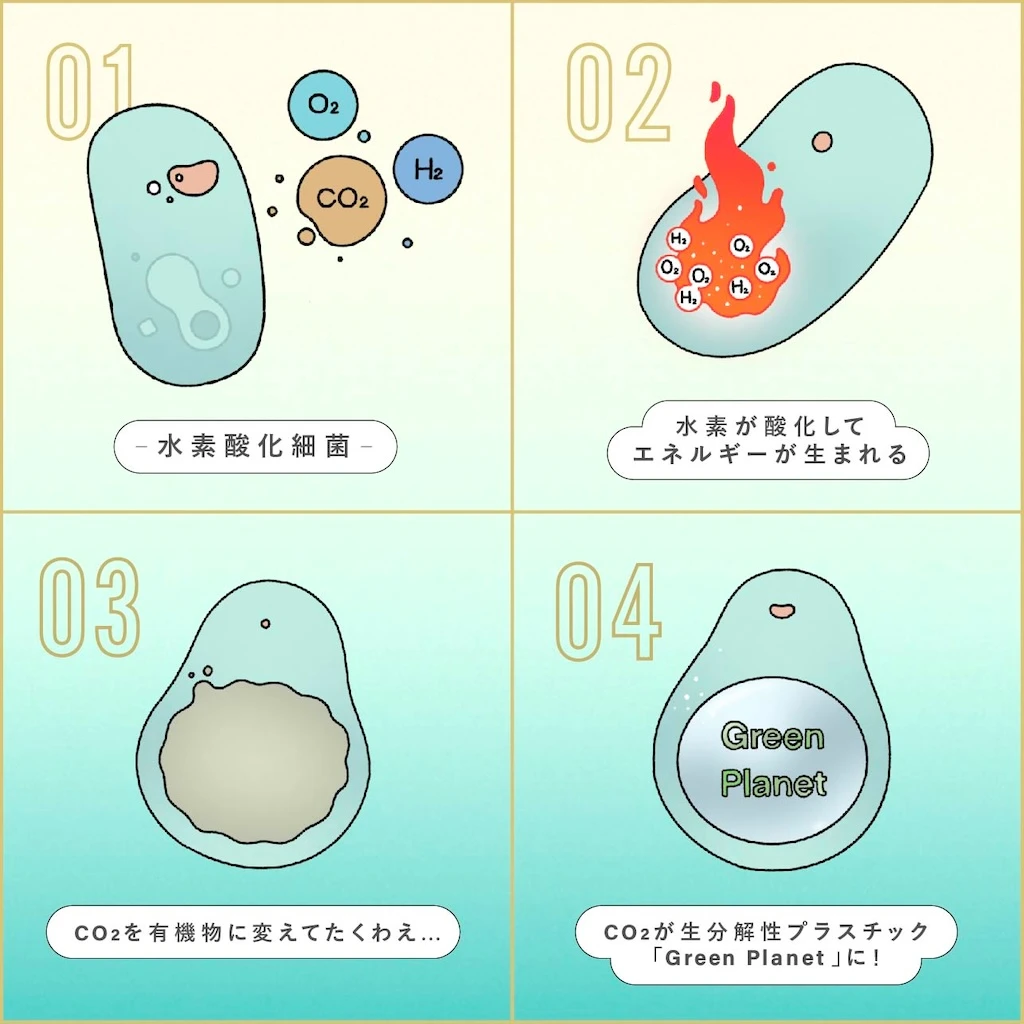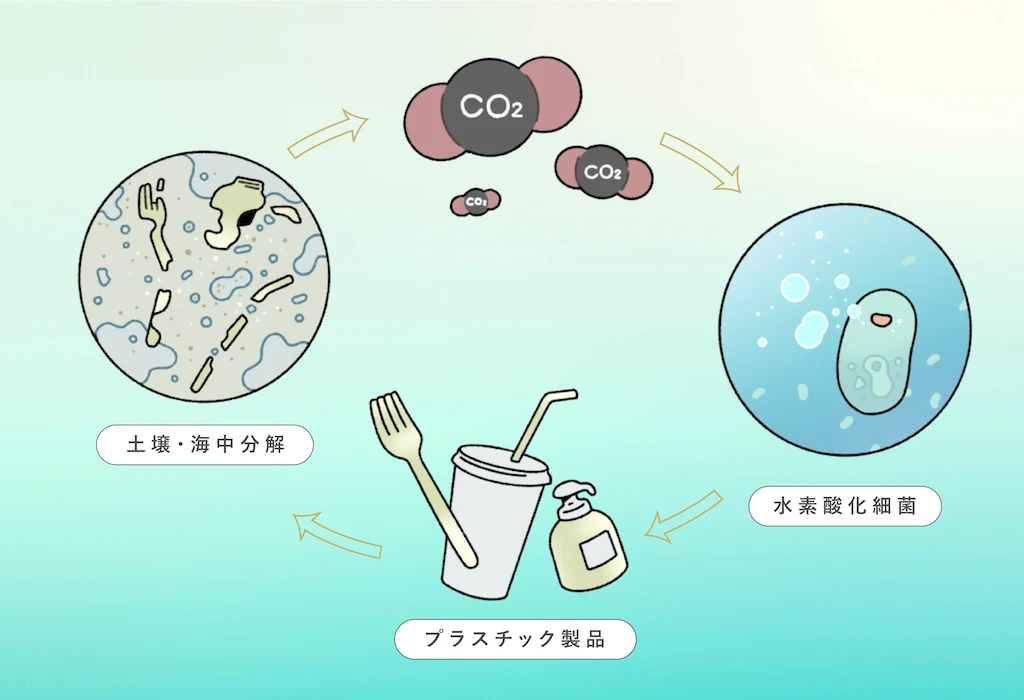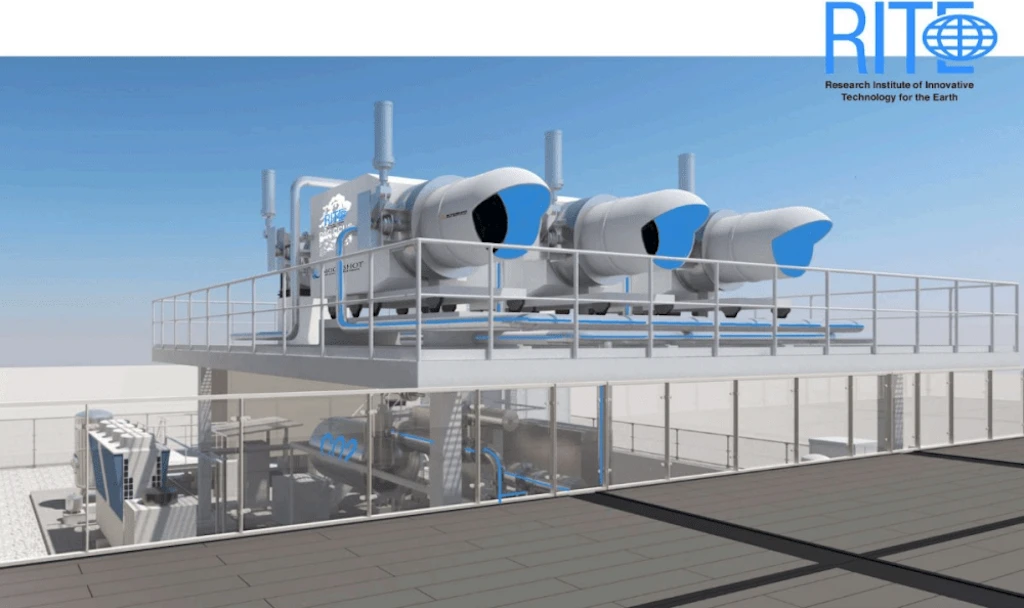Feature
The Amazing Bacteria That “Eats” CO₂

Index
How CO₂ Turns into Biodegradable Plastic
Biodegradable Plastic Development: From Plant Oils to Innovation
The Current Status of CO₂-Based Biodegradable Plastic Development
A Promising Vision of a Bright Future with CO₂ Circulation
A Showcase of Cutting-Edge CO₂ Reduction Technology
Among the many challenges facing the world in the 21st century, climate change is undoubtedly one of the most urgent. A major contributor to this issue is the release of greenhouse gases, such as CO₂, produced by human activities.The key to solving this lies in remarkable new technologies designed to reduce CO₂ in the atmosphere.
One standout innovation comes from Kaneka Corporation, a leading Japanese chemical manufacturer and a partner in the Japan Pavilion's exhibit. Their breakthrough involves cultivating special microorganisms that rapidly consume CO₂ and use it as a nutrient to efficiently produce biodegradable plastic — an eco-friendly alternative to conventional plastics.Even if this biodegradable plastic were to end up in the ocean, marine microorganisms would naturally break it down, returning it safely to the environment.A solution that cuts CO₂, creates sustainable plastic, and supports marine ecosystems — this innovation feels like a triple win for humanity.
To learn more about the science behind this remarkable technology, we spoke with Dr. Shunsuke Sato, Director of Kaneka's CO₂ Innovation Laboratory.
How CO₂ Turns into Biodegradable Plastic
The microorganism at the heart of Kaneka’s groundbreaking, triple-benefit technology is called hydrogen-oxidizing bacteria. To understand how this process works, we asked Dr. Shunsuke Sato, Director of Kaneka’s CO₂ Innovation Laboratory, explained it in simple terms.

Sato
In fact, hydrogen-oxidizing bacteria have existed since the very beginning of life on Earth. These microorganisms are naturally found in environments like soil and oceans. When provided with hydrogen, oxygen, and CO₂, these bacteria consume them, using the energy produced by oxidizing hydrogen to convert CO₂ into organic matter, which they store within their cells. Essentially, the bacteria store CO₂ in a way similar to how humans store fat. Our research focuses on cultivating these bacteria to efficiently convert CO₂ into what we call Kaneka Biodegradable Biopolymer Green Planet (commonly known as “Green Planet”). We then extract this material and industrialize it for practical use.

It was Sato who developed the groundbreaking technology that gave the hydrogen-oxidizing bacteria — microorganisms abundant in our everyday environment — the ability to produce Green Planet.

Sato
In our daily lives, we generally dispose of waste properly in trash bins. Yet, despite this, an estimated 8 million tons of plastic still end up in the oceans each year*. This means that, inevitably, some plastics unintentionally escape into the environment. Since this accumulation is now causing serious problems, I believe that future plastics must be designed with the ability to biodegrade naturally if they end up in the environment. Without such innovation, we may eventually face a future where continuing to use plastic becomes unsustainable.
*Ministry of Enviornment:https://www.env.go.jp/policy/hakusyo/r01/html/hj19010301.html

Biodegradable Plastic Development: From Plant Oils to Innovation
The question arises: why did Kaneka embark on this research in the first place?

Sato
Kaneka began its research in the early 1990s, a time when plastic waste was primarily disposed of in landfills rather than being incinerated. The growing concern back then was the risk of landfills reaching capacity and the resulting soil contamination. While CO₂ emissions were not yet widely recognized as a major issue, Kaneka started developing biodegradable plastic as a solution for plastic waste — a material designed to break down naturally in the soil through microbial action. In the early 2000s, advancements in waste incineration technology improved the ability to safely burn plastic waste, which temporarily reduced interest in biodegradable plastics. Meanwhile, concerns about climate change emerged as rising atmospheric CO₂ levels gained attention. This shift led to increased research into biomass plastics — sustainable alternatives made from renewable resources rather than petroleum. More recently, however, the alarming issue of microplastic pollution in oceans has reignited global interest in biodegradable plastics — particularly those capable of decomposing even in marine environments.
Kaneka is currently supplying straws and disposable cutlery made from Green Planet, a biodegradable plastic derived from plant oils, to convenience stores and cafes. Chances are, some of the plastic products you use every day are already made from biodegradable materials.
The Current Status of CO₂-Based Biodegradable Plastic Development

Sato
At the same time, the issue of global warming caused by CO₂ gained increasing attention. We had already anticipated the possibility of shifting from plant oil to CO₂ as a raw material during our development of biodegradable plastic. This was because the supply of plant oil is inherently limited. Since 2023, with support from the New Energy and Industrial Technology Development Organization (NEDO), we have officially launched full-scale research into new microorganisms and manufacturing processes that can directly use CO₂ as a raw material to produce Green Planet.
The seemingly too-good-to-be-true idea of creating biodegradable plastic from CO₂ has now started to move toward reality. Currently, research and development are reportedly progressing smoothly.

Sato
Hydrogen-oxidizing bacteria can absorb CO₂ far more efficiently than plants through photosynthesis. This is because photosynthesis relies on sunlight, meaning plants can only absorb CO₂ across the total surface area exposed to light. In contrast, hydrogen-oxidizing bacteria use hydrogen as their energy source. Since hydrogen dissolves in water, these bacteria can absorb CO₂ throughout the entire volume of the water, not just across a flat surface. Additionally, while plants only perform photosynthesis during daylight hours, hydrogen-oxidizing bacteria can operate day and night. Currently, we are scaling up our bacterial cultivation system. By March 2025, we plan to launch a demonstration experiment using a 200-liter cultivation tank. Progress so far has been in line with the original blueprint we envisioned at the start of development. Our ultimate goal is to conduct a large-scale demonstration using a 100,000-liter commercial-scale cultivation tank. After establishing a demonstration plant by the 2030 fiscal year, we aim to introduce Green Planet products to the market. Alongside scaling up the cultivation process, we are also working to further enhance the bacteria's capabilities to improve efficiency and performance.
If this technology is successfully implemented in society, it will not only make a significant contribution to mitigating global warming but also serve as a valuable step toward achieving carbon recycling.
A Promising Vision of a Bright Future with CO₂ Circulation
At the Japan Pavilion at the upcoming Osaka-Kansai Expo, Kaneka's innovative process — where hydrogen-oxidizing bacteria absorb CO₂, oxygen, and hydrogen to produce Green Planet — will be showcased through an easy-to-understand CG animation in the Farm Area. In addition, visitors will see tableware made from Green Planet, designed by the pavilion's General Producer/Designer, Oki Sato. Moving on to the Plant Area, visitors will witness how this Green Planet tableware breaks down in seawater through microbial action. As the material decomposes, it returns to CO₂ and water, visually illustrating the complete cycle of CO₂ circulation — a powerful reminder of the interconnectedness of nature and sustainable innovation.

A Showcase of Cutting-Edge CO₂ Reduction Technology
At the Osaka-Kansai Expo, in addition to Kaneka's hydrogen-oxidizing bacteria project, various other cutting-edge technologies aimed at reducing CO₂ will also be showcased. Let's take a closer look at some of these innovative solutions.

First, let's look at eco-friendly concrete, a material that has already begun to see practical use. Traditional concrete is made from cement, gravel, sand, and water. However, cement production generates a significant amount of CO₂ during the manufacturing process. To address this, eco-friendly concrete replaces part of the cement with special materials that absorb CO₂ or with industrial by-products, successfully reducing CO₂ emissions. At the Osaka-Kansai Expo, visitors will find structures such as a dome (by Kajima, Takenaka Corporation, and others) and benches (by Ando Hazama) made from this innovative concrete.

Next, let's look at Direct Air Capture (DAC) — a technology that directly absorbs CO₂ from the air. While various countries are actively developing this technology, what makes DAC particularly noteworthy is its ability to recover large amounts of CO₂ that has already been released and accumulated in the atmosphere. Although rising CO₂ levels are a major driver of climate change, CO₂ only makes up about 0.04% of the air we breathe. At present, DAC is considered the only technology capable of efficiently capturing this low-concentration CO₂ dispersed across Earth's atmosphere. Another advantage of DAC is its efficient operation in limited spaces and with minimal water usage. In fact, several DAC plants are already in operation overseas. At the Osaka-Kansai Expo, the research institute RITE will install and operate a DAC demonstration plant as part of its “Forest of the Future” exhibit. Visitors will have the opportunity to join guided tours showcasing this innovative technology in action.
The captured CO₂ will be utilized in several ways: Converted into methane at a methanation plant for use in kitchens at the reception hall, transformed into dry ice for practical applications, and by 2030, integrated into the production of biodegradable plastics, eco-friendly concrete, biojet fuel, and polycarbonate materials. Addressing CO₂ as a valuable resource rather than simply a harmful pollutant is key to achieving meaningful solutions. By strategically incorporating CO₂ into a sustainable cycle, we can turn this environmental challenge into an opportunity for innovation.
For example, a promising future could see DAC-captured CO₂ transformed by hydrogen-oxidizing bacteria into biodegradable plastics — an exciting collaboration that’s no longer just a distant dream.

In addition, the Iida Group Holdings × Osaka Metropolitan University Joint Pavilion, a standout example of industry-academia collaboration, will showcase their jointly developed artificial photosynthesis technology, designed to promote energy self-sufficiency in homes. The Osaka-Kansai Expo serves as a showcase for cutting-edge CO₂ reduction technologies, offering a glimpse into Japan's current efforts to achieve carbon neutrality by 2050, the ultimate goal set by the Paris Agreement.
To conclude, let’s once again hear from Dr. Sato of Kaneka.

Sato
I have children myself, and I really hope that many young people and children will visit. While it may be difficult to envision a hopeful future in today’s social climate, we are presenting a vision of a brighter tomorrow — one grounded in science and technology. By experiencing a future shaped by various cycles that coexist with our planet’s environment, I believe visitors will be able to discover a sense of hope and optimism.
Let’s Share!
So many innovative ideas for utilizing CO₂ while reducing its impact!
Share your Monthly JP pavilion and circulate your thoughts.
